Lubricity and Rheological Properties of Highly Dispersed Graphite in Clay-Water-Based Drilling Fluids
Abstract
:1. Introduction
2. Experimental Materials and Methods
2.1. Materials and Reagents
2.2. Drilling Fluid Evaluation
2.3. Screening the Amount of CTAC
2.4. Infrared Spectroscopy
2.5. Contact Angle Measurement
2.6. Laser Particle Size Measurement
2.7. Zeta Potential Measurement
2.8. X-ray Diffraction
3. Results and Discussion
3.1. Graphite Sedimentation Experiment
3.2. Infrared Spectroscopy
3.3. Contact Angle Measurement
3.4. Particle Size Measurement
3.5. Zeta Potential Measurement
3.6. X-ray Diffraction Analysis
3.7. Scanning Electron Microscopy
3.8. Performance in Drilling Fluid
3.9. Mechanism
4. Conclusions
Author Contributions
Funding
Institutional Review Board Statement
Informed Consent Statement
Data Availability Statement
Acknowledgments
Conflicts of Interest
References
- Razali, S.Z.; Yunus, R.; Rashid, S.A.; Lim, H.N.; Jan, B.M. Review of biodegradable synthetic-based drilling fluid: Progression, performance and future prospect. Renew. Sustain. Energy Rev. 2018, 90, 171–186. [Google Scholar] [CrossRef]
- Ikram, R.; Jan, B.M.; Vejpravova, J. Towards recent tendencies in drilling fluids: Application of carbon-based nanomaterials. J. Mater. Res. Technol. 2021, 15, 3733–3758. [Google Scholar] [CrossRef]
- Ikram, R.; Jan, B.M.; Sidek, A.; Kenanakis, G. Utilization of Eco-Friendly Waste Generated Nanomaterials in Water-Based Drilling Fluids; State of the Art Review. Materials 2021, 14, 4171. [Google Scholar] [CrossRef] [PubMed]
- Perumalsamy, J.; Gupta, P.; Sangwai, J.S. Performance evaluation of esters and graphene nanoparticles as an additives on the rheological and lubrication properties of water-based drilling mud. J. Pet. Sci. Eng. 2021, 204, 108680. [Google Scholar] [CrossRef]
- Su, Z.G.; Wang, R.H.; Liu, J.Y.; Chen, E.D.; Zhong, H.Y.; Zhao, X.; Huang, W.A. Experimental study on a novel environmen-tal-high cost performance lubricant HPR-1 used in water-based drilling fluid. Fresenius Environ. Bull. 2020, 29, 2483–2490. [Google Scholar]
- Sadeghalvaad, M.; Sabbaghi, S. The effect of the TiO2/polyacrylamide nanocomposite on water-based drilling fluid properties. Powder Technol. 2015, 272, 113–119. [Google Scholar] [CrossRef]
- Li, Z.; Zhang, J.; Qu, C.; Tang, Y.; Slaný, M. Synthesis of Mg-Al Hydrotalcite Clay with High Adsorption Capacity. Materials 2021, 14, 7231. [Google Scholar] [CrossRef]
- Liu, Q.; Bai, Y.; Dong, S.; Li, J.; Song, Z.; Chen, S.; Zhang, J.; Chen, G. Preparation and the Foaming Activity Study of Hydroxymethyl Cetyltrimethyl Ammonium Chloride. Tenside Surfactants Deterg. 2021, 58, 153–160. [Google Scholar] [CrossRef]
- Shettigar, R.R.; Misra, N.M.; Patel, K. Cationic surfactant (CTAB) a multipurpose additive in polymer-based drilling fluids. J. Pet. Explor. Prod. Technol. 2017, 8, 597–606. [Google Scholar] [CrossRef] [Green Version]
- Ibrahim, D.S.; Sami, N.A.; Balasubramanian, N. Effect of barite and gas oil drilling fluid additives on the reservoir rock characteristics. J. Pet. Explor. Prod. Technol. 2017, 7, 281–292. [Google Scholar] [CrossRef] [Green Version]
- Sun, J.; Chang, X.; Lv, K.; Wang, J.; Zhang, F.; Jin, J.; Zhou, X.; Dai, Z. Environmentally friendly and salt-responsive polymer brush based on lignin nanoparticle as fluid-loss additive in water-based drilling fluids. Colloids Surf. A Physicochem. Eng. Asp. 2021, 621, 126482. [Google Scholar] [CrossRef]
- Siddique, S.; Kwoffie, L.; Addae-Afoakwa, K.; Yates, K.; Njuguna, J. Oil Based Drilling Fluid Waste: An Overview on Environmentally Persistent Pollutants. IOP Conf. Series Mater. Sci. Eng. 2017, 195, 12008. [Google Scholar] [CrossRef] [Green Version]
- Lee, H.; Lee, H.-B.-R.; Kwon, S.; Salmeron, M.; Park, J.Y. Internal and External Atomic Steps in Graphite Exhibit Dramatically Different Physical and Chemical Properties. ACS Nano 2015, 9, 3814–3819. [Google Scholar] [CrossRef] [PubMed]
- Yu, J.-S.; Ha, D.-H.; Kim, J.-H. Mapping of the atomic lattice orientation of a graphite flake using macroscopic liquid crystal texture. Nanotechnology 2012, 23, 395704. [Google Scholar] [CrossRef]
- Qin, G.; Xu, M.; He, M.; Chen, K. Synergistic Effect of Polyaspartate and Polyethylene Glycol on Lubrication Performance of the Water-Based Drilling Mud. ACS Omega 2021, 6, 13817–13830. [Google Scholar] [CrossRef]
- William, J.K.M.; Gupta, P.; Sangwai, J.S. Interaction of lubricants on the rheological and filtration loss properties of water-based drilling fluids. Pet. Sci. Technol. 2021, 39, 235–248. [Google Scholar] [CrossRef]
- Ali, M.; Jarni, H.H.; Aftab, A.; Ismail, A.R.; Saady, N.M.C.; Sahito, M.F.; Keshavarz, A.; Iglauer, S.; Sarmadivaleh, M. Nanomaterial-Based Drilling Fluids for Exploitation of Unconventional Reservoirs: A Review. Energies 2020, 13, 3417. [Google Scholar] [CrossRef]
- Luo, X.; Han, W.L.; Ren, H.; Zhuang, Q.Z. Experimental study of a novel environmental friendly, high performance lubricant for water based drilling fluid. Fresenius Environ. Bull. 2019, 28, 5624–5631. [Google Scholar]
- Rana, A.; Khan, I.; Saleh, T.A. Advances in Carbon Nanostructures and Nanocellulose as Additives for Efficient Drilling Fluids: Trends and Future Perspective—A Review. Energy Fuels 2021, 35, 7319–7339. [Google Scholar] [CrossRef]
- Yu, X.Z. The application of solid lubricants-graphite powder in well completion operations. Pet. Drill. Prod. Technol. 1985, 9, 38. [Google Scholar]
- Tian, J. The effect of graphite crystal structure and graphite intercalation compounds on friction properties. New Carbon Mater. 1995, 33, 54–58. [Google Scholar]
- Liu, X.; He, X.; Lin, Y.; Zhuang, J.; Hao, J. Enhanced adhesion strength and solid lubricity of graphite like amorphous carbon films by hydrogen implantation. Surf. Coat. Technol. 2021, 412, 127013. [Google Scholar] [CrossRef]
- Restuccia, P.; Ferrario, M.; Righi, M. Monitoring water and oxygen splitting at graphene edges and folds: Insights into the lubricity of graphitic materials. Carbon 2020, 156, 93–103. [Google Scholar] [CrossRef]
- Motozuka, S.; Sato, H.; Muramatsu, Y.; Morinaga, M. Interfacial effect between graphite and iron substrate on basal plane orientation and lubricity of graphite. Tribol. Int. 2020, 151, 106455. [Google Scholar] [CrossRef]
- Liu, X.; Gao, L.; Wang, Q.; Gu, X.; Du, W.; Zhang, J.; Gang, C. Evaluation and application of poly(ethylene glycol) as lubricant in water-based drilling fluid for horizontal well in Sulige Gas Field. Polym. Int. 2020, 70, 83–89. [Google Scholar] [CrossRef]
- Kosynkin, D.V.; Ceriotti, G.; Wilson, K.C.; Lomeda, J.R.; Scorsone, J.T.; Patel, A.D.; Friedheim, J.E.; Tour, J.M. Graphene Oxide as a High-Performance Fluid-Loss-Control Additive in Water-Based Drilling Fluids. ACS Appl. Mater. Interfaces 2012, 4, 222–227. [Google Scholar] [CrossRef] [PubMed]
- Du, W.-C.; Wang, X.-Y.; Liu, M.; Bi, T.-F.; Song, S.-X.; Zhang, J.; Chen, G. Synthesis and performance of AM/SSS/THDAB as clay hydration dispersion inhibitor. Polímeros 2019, 29, 2019053. [Google Scholar] [CrossRef]
- Rana, A.; Arfaj, M.K.; Yami, A.S.; Saleh, T.A. Cetyltrimethylammonium modified graphene as a clean swelling inhibitor in water-based oil-well drilling mud. J. Environ. Chem. Eng. 2020, 8, 103802. [Google Scholar] [CrossRef]
- Ni, W.; Wang, W.; Wang, Q.; Du, W.; Chen, G. Modification and Application of Waste Shaddock Peel as a Green Additive for Water-Based Drilling Fluid. J. Biobased Mater. Bioenergy 2021, 15, 380–384. [Google Scholar] [CrossRef]
- Jing, Y.; Zhang, J.; Hu, W.; Du, W.; Xie, J.; Qu, C.; Chen, G. Preparation and Evaluation of Ammonium-Succinic Salts as Shale Swelling Inhibitor and Its Application in Water-Based Drilling Fluids. Russ. J. Phys. Chem. B 2021, 15, S102–S108. [Google Scholar] [CrossRef]
- Xian, S.; Chen, S.; Lian, Y.; Du, W.; Song, Z.; Chen, G. Preparation and Evaluation of Ammonium Adipate Solutions as Inhibitors of Shale Rock Swelling. Minerals 2021, 11, 1013. [Google Scholar] [CrossRef]
- Zhang, W.; Slaný, M.; Zhang, J.; Liu, Y.; Zang, Y.; Li, Y.; Chen, G. Acetylation Modification of Waste Polystyrene and Its Use as a Crude Oil Flow Improver. Polymers 2021, 13, 2505. [Google Scholar] [CrossRef] [PubMed]
- Gao, M.; Tian, W.; Ma, Z.; Dong, S.; Ke, C.; Zhang, J.; Chen, G. Research of a Surfactant Gel with Potential Application in Oilfield. Tenside Surfactants Deterg. 2021, 58, 360–370. [Google Scholar] [CrossRef]
- Gang, C.; Gao, L.; Sun, Y.; Gu, X.; Hu, W.; Du, W.; Zhang, J.; Qu, C. A Green Shale Inhibitor Developed from Lignin Sulfonate and the Mechanism Study. J. Biobased Mater. Bioenergy 2019, 13, 778–783. [Google Scholar] [CrossRef]
- Antonelou, A.; Benekou, V.; Drakopoulos, V.; Kollia, M.; Yannopoulos, S.N. Laser-induced transformation of graphitic materials to two-dimensional graphene-like structures at ambient conditions. Nanotechnology 2018, 29, 384001. [Google Scholar] [CrossRef]
- Zhang, R.; Gao, L.; Duan, W.; Hu, W.; Du, W.; Gu, X.; Zhang, J.; Chen, G. The Application of Ferric Chloride-Lignin Sulfonate as Shale Inhibitor in Water-Based Drilling Fluid. Molecules 2019, 24, 4331. [Google Scholar] [CrossRef] [Green Version]
- Du, W.; Wang, X.; Bi, T.; Liu, M.; Zhang, J.; Chen, G. Synthesis and Inhibitive Mechanism of a Novel Clay Hydration Inhibitor for Water-based Drilling Fluids. Mater. Sci. 2021, 27, 210–216. [Google Scholar] [CrossRef]
- Du, W.; Wang, X.; Chen, G.; Zhang, J.; Slaný, M. Synthesis, Property and Mechanism Analysis of a Novel Polyhydroxy Organic Amine Shale Hydration Inhibitor. Minerals 2020, 10, 128. [Google Scholar] [CrossRef] [Green Version]
- Pakdaman, E.; Osfouri, S.; Azin, R.; Niknam, K.; Roohi, A. Improving the rheology, lubricity, and differential sticking properties of water-based drilling muds at high temperatures using hydrophilic Gilsonite nanoparticles. Colloids Surfaces A Physicochem. Eng. Asp. 2019, 582, 123930. [Google Scholar] [CrossRef]
- Kania, D.; Yunus, R.; Omar, R.; Rashid, S.A.; Jan, B.M.; Aulia, A. Lubricity performance of non-ionic surfactants in high-solid dillig fluids: A perspective from quantum chemical calculations and filtration properties. J. Pet. Sci. Eng. 2001, 207, 109162. [Google Scholar] [CrossRef]

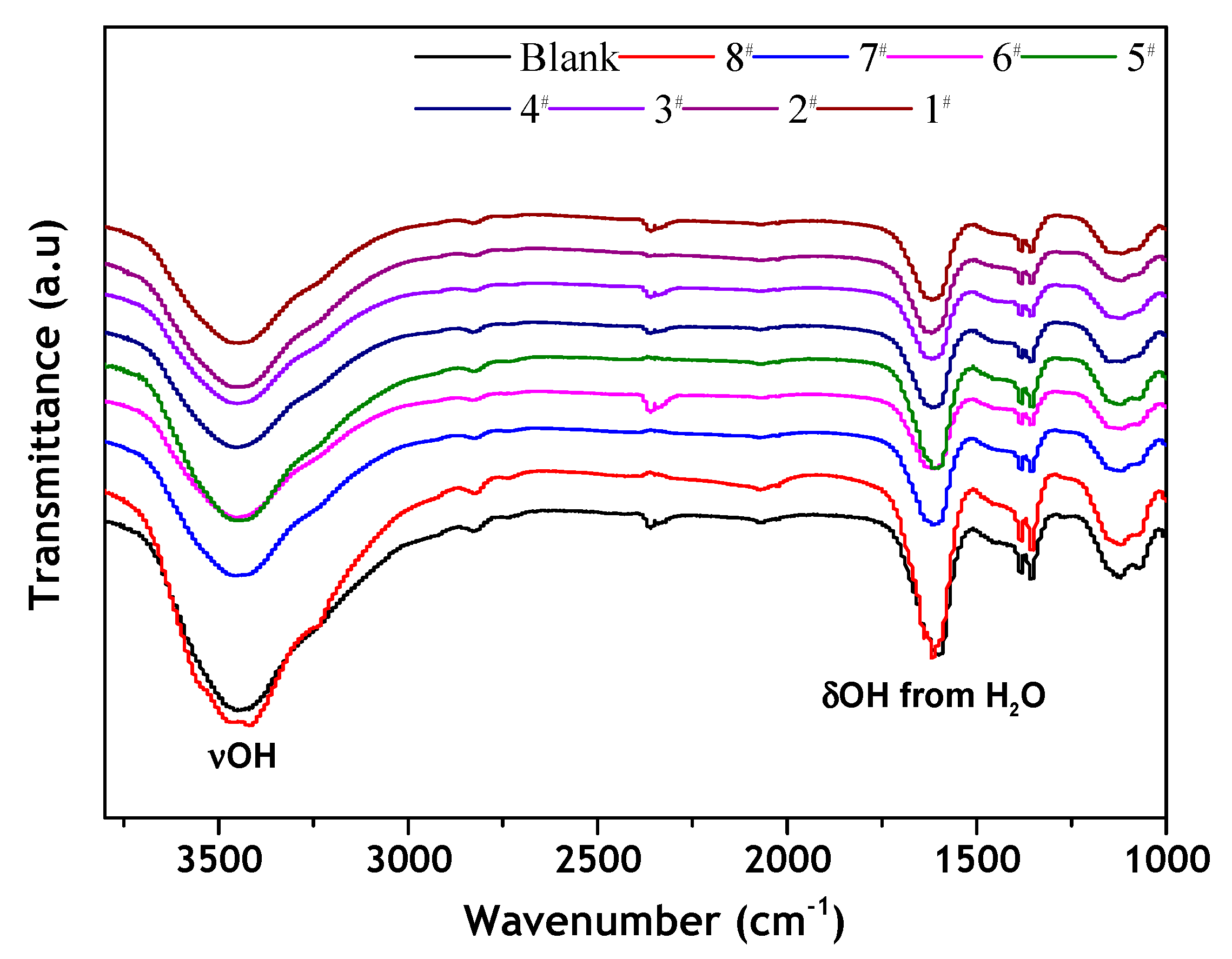
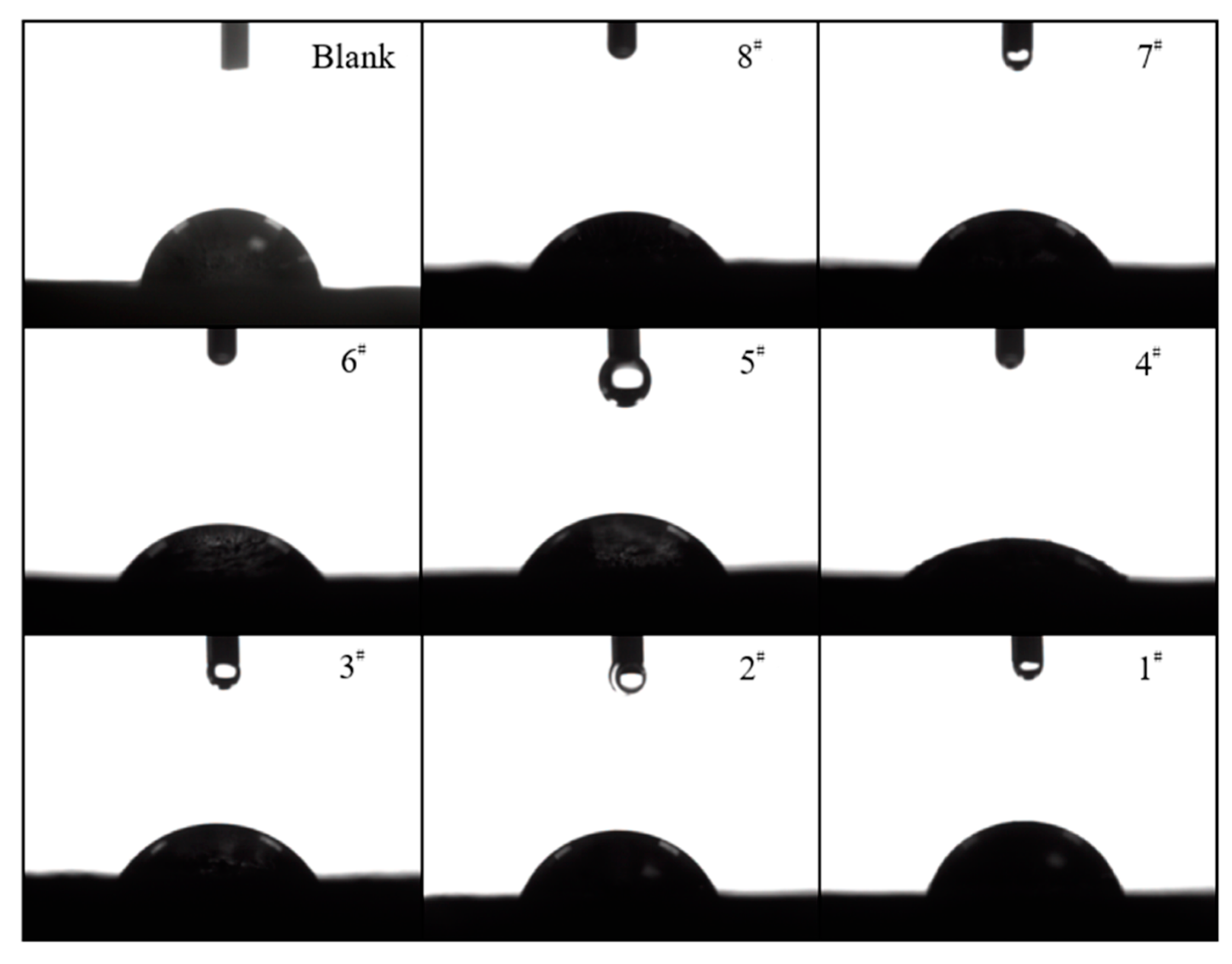

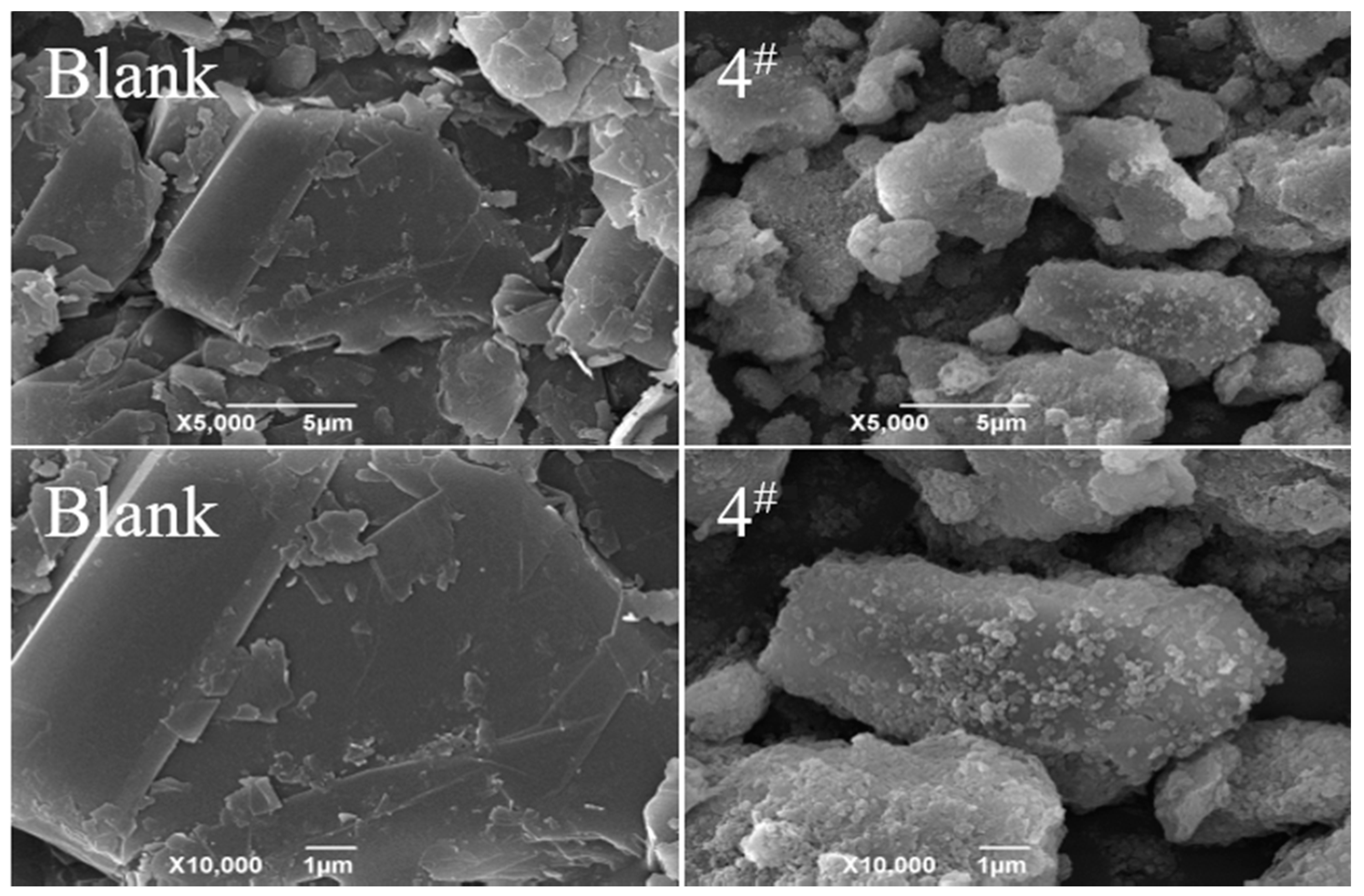
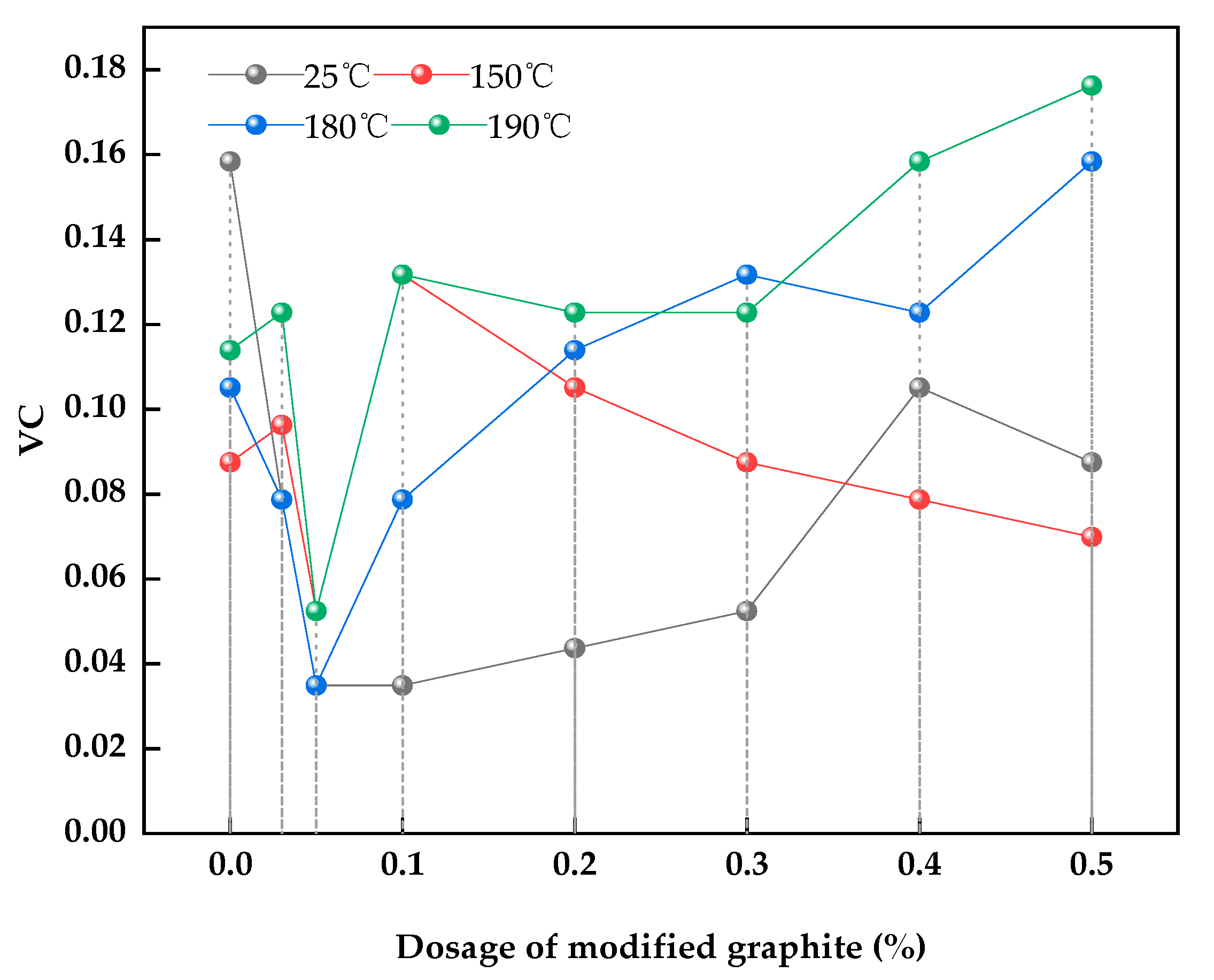
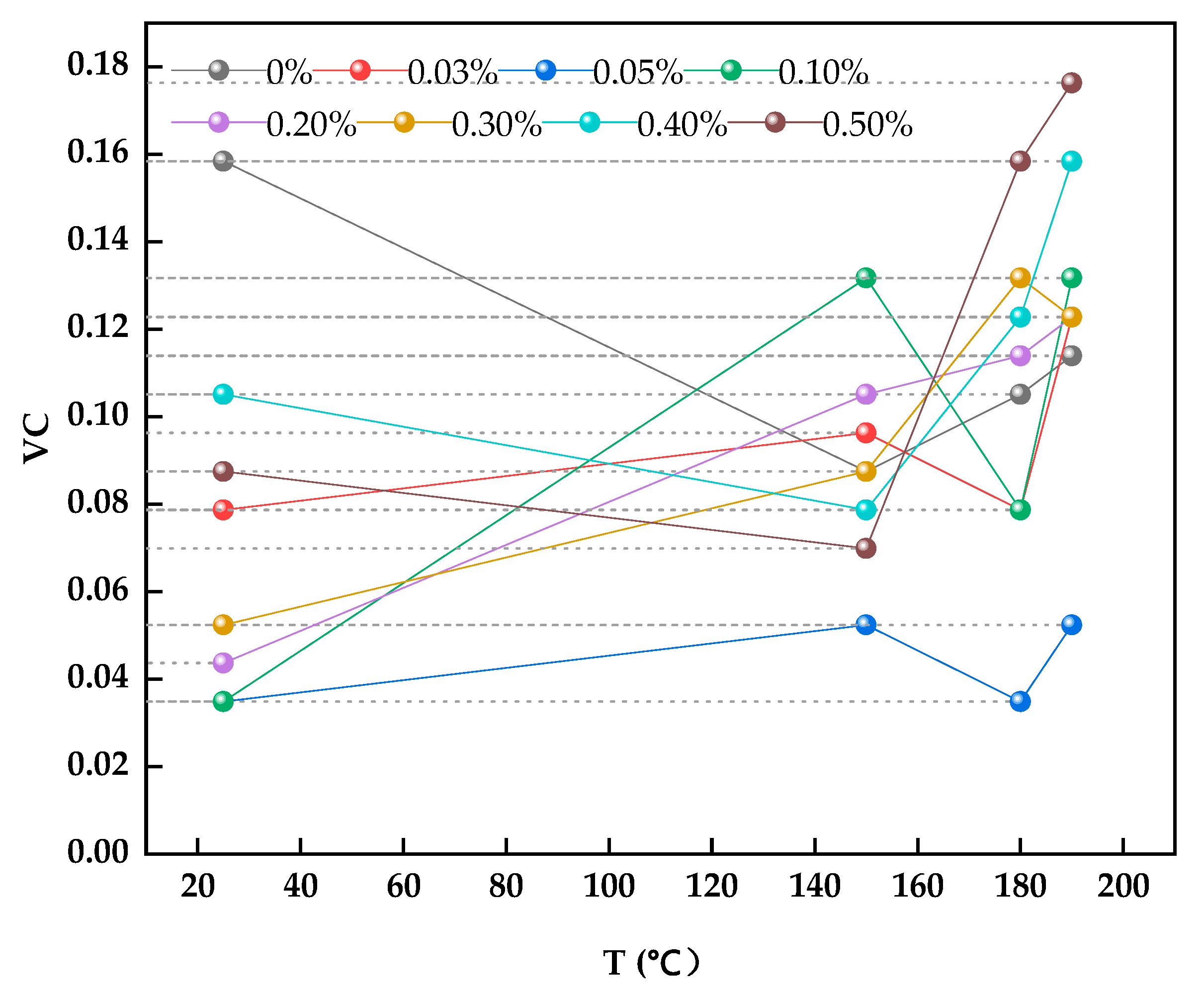
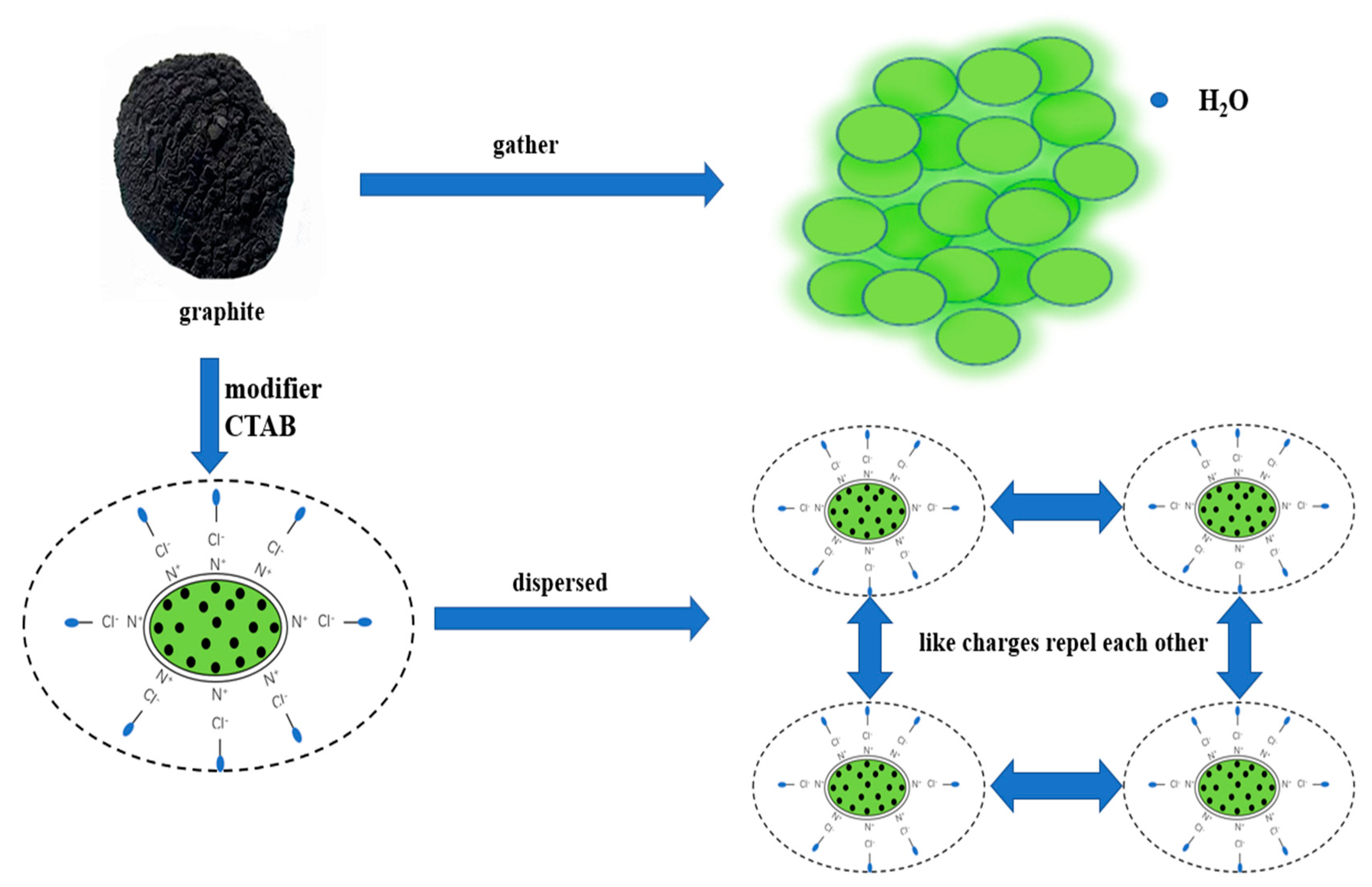
| Component | Function | Type | Value |
|---|---|---|---|
| Tap water (mL) | Fluid base | - | 350 |
| Calcium bentonite (g) | Drilling mud | Industrial grade | 14 |
| Sodium carbonate (g) | Hardness control | Analytical purity | 0.7 |
| CTAC (g) | Modification | Analytical purity | - |
| Graphite (g) | Lubrication | Industrial grade | - |
| Sample No. | Graphite (g) | CTAC (g) | Dosage of CTAC on Graphite (g/g) |
|---|---|---|---|
| 1 | 4.00 | 0.020 | 0.005 |
| 2 | 4.00 | 0.027 | 0.007 |
| 3 | 4.00 | 0.040 | 0.010 |
| 4 | 4.00 | 0.080 | 0.020 |
| 5 | 4.00 | 0.100 | 0.025 |
| 6 | 4.00 | 0.130 | 0.033 |
| 7 | 4.00 | 0.200 | 0.050 |
| 8 | 4.00 | 0.400 | 0.100 |
| Sample No. | Left Contact Angle Value (°) | Right Contact Angle Value (°) | Mean Contact Angle (°) |
|---|---|---|---|
| 1 | 80.50 | 80.00 | 80.25 |
| 2 | 72.50 | 72.00 | 72.25 |
| 3 | 66.00 | 65.50 | 65.75 |
| 4 | 55.00 | 57.00 | 56.00 |
| 5 | 36.50 | 37.50 | 37.00 |
| 6 | 50.00 | 59.50 | 59.75 |
| 7 | 56.50 | 56.00 | 56.25 |
| 8 | 62.50 | 59.00 | 60.75 |
| Sample No. | The Average Particle Size (μm) | Median Particle Size (μm) |
|---|---|---|
| Blank | 102.80 | 90.25 |
| 1 | 25.11 | 18.98 |
| 2 | 17.10 | 13.71 |
| 3 | 15.45 | 12.54 |
| 4 | 10.03 | 7.93 |
| 5 | 11.89 | 9.53 |
| 6 | 15.85 | 12.57 |
| 7 | 17.77 | 14.60 |
| 8 | 22.04 | 19.68 |
| Sample No. | Zeta Potential Value (mV) |
|---|---|
| Blank | 8.65 |
| 1 | 30.77 |
| 2 | 35.05 |
| 3 | 35.49 |
| 4 | 40.86 |
| 5 | 50.25 |
| 6 | 50.19 |
| 7 | 59.71 |
| 8 | 65.30 |
| Temperature (°C) | Dosage of Modified Graphite (%) | PV (mPa·s) | YP (Pa) | AV (mPa·s) | FL (mL) | VC |
|---|---|---|---|---|---|---|
| 25 | 0 | 3.00 | 0.20 | 3.00 | 16.5 | 0.1584 |
| 0.03 | 3.00 | 0.20 | 3.00 | 16.2 | 0.0787 | |
| 0.05 | 2.50 | 0.50 | 3.00 | 16.4 | 0.0349 | |
| 0.10 | 2.50 | 0.50 | 3.00 | 15.8 | 0.0349 | |
| 0.20 | 3.00 | 0.25 | 3.25 | 15.5 | 0.0437 | |
| 0.30 | 2.50 | 0.50 | 3.00 | 16.0 | 0.0524 | |
| 0.40 | 2.50 | 0.50 | 3.00 | 15.0 | 0.1051 | |
| 0.50 | 1.50 | 1.25 | 2.75 | 16.0 | 0.0875 | |
| 150 | 0 | 3.00 | 0.25 | 3.25 | 18.4 | 0.0875 |
| 0.03 | 3.00 | 0.20 | 3.00 | 23.4 | 0.0963 | |
| 0.05 | 3.00 | 0.20 | 3.00 | 21.9 | 0.0524 | |
| 0.10 | 4.00 | 0.25 | 4.25 | 26.5 | 0.1317 | |
| 0.20 | 3.00 | 0.25 | 3.50 | 22.5 | 0.1051 | |
| 0.30 | 3.50 | 0.50 | 4.00 | 24.5 | 0.0875 | |
| 0.40 | 3.50 | 0.25 | 3.75 | 25.0 | 0.0787 | |
| 0.50 | 2.50 | 0.50 | 3.00 | 18.0 | 0.0699 | |
| 180 | 0 | 3.00 | 0.20 | 3.00 | 20.1 | 0.1051 |
| 0.03 | 2.50 | 0.25 | 2.75 | 25.6 | 0.0787 | |
| 0.05 | 2.50 | 0.25 | 2.75 | 24.4 | 0.0349 | |
| 0.10 | 3.50 | 0.50 | 4.00 | 32.0 | 0.0787 | |
| 0.20 | 3.00 | 0.25 | 3.25 | 32.5 | 0.1139 | |
| 0.30 | 4.00 | 0.25 | 4.25 | 41.5 | 0.1317 | |
| 0.40 | 3.00 | 0.25 | 3.25 | 30.5 | 0.1228 | |
| 0.50 | 3.50 | 0.50 | 4.00 | 28.5 | 0.1584 | |
| 190 | 0 | 3.25 | 0.25 | 3.50 | 22.3 | 0.1139 |
| 0.03 | 3.00 | 0.25 | 3.00 | 28.2 | 0.1228 | |
| 0.05 | 2.50 | 0.50 | 3.00 | 27.5 | 0.0524 | |
| 0.10 | 3.50 | 0.50 | 3.50 | 31.5 | 0.1317 | |
| 0.20 | 3.50 | 0.25 | 3.75 | 29.6 | 0.1228 | |
| 0.30 | 3.00 | 0.75 | 3.75 | 32.5 | 0.1228 | |
| 0.40 | 3.00 | 0.25 | 3.00 | 27.0 | 0.1584 | |
| 0.50 | 3.00 | 0.50 | 3.50 | 29.5 | 0.1763 |
Publisher’s Note: MDPI stays neutral with regard to jurisdictional claims in published maps and institutional affiliations. |
© 2022 by the authors. Licensee MDPI, Basel, Switzerland. This article is an open access article distributed under the terms and conditions of the Creative Commons Attribution (CC BY) license (https://creativecommons.org/licenses/by/4.0/).
Share and Cite
Wang, Q.; Slaný, M.; Gu, X.; Miao, Z.; Du, W.; Zhang, J.; Gang, C. Lubricity and Rheological Properties of Highly Dispersed Graphite in Clay-Water-Based Drilling Fluids. Materials 2022, 15, 1083. https://doi.org/10.3390/ma15031083
Wang Q, Slaný M, Gu X, Miao Z, Du W, Zhang J, Gang C. Lubricity and Rheological Properties of Highly Dispersed Graphite in Clay-Water-Based Drilling Fluids. Materials. 2022; 15(3):1083. https://doi.org/10.3390/ma15031083
Chicago/Turabian StyleWang, Quande, Michal Slaný, Xuefan Gu, Zhipeng Miao, Weichao Du, Jie Zhang, and Chen Gang. 2022. "Lubricity and Rheological Properties of Highly Dispersed Graphite in Clay-Water-Based Drilling Fluids" Materials 15, no. 3: 1083. https://doi.org/10.3390/ma15031083
APA StyleWang, Q., Slaný, M., Gu, X., Miao, Z., Du, W., Zhang, J., & Gang, C. (2022). Lubricity and Rheological Properties of Highly Dispersed Graphite in Clay-Water-Based Drilling Fluids. Materials, 15(3), 1083. https://doi.org/10.3390/ma15031083







